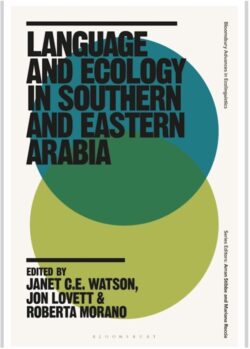New Publication: Language and Ecology in Southern and Eastern Arabia
Written by Roberta Morano
Centre member Roberta Morano discusses a new volume co-edited with fellow centre members Janet C.E. Watson and Jon Lovett
In the age of globalisation and superfast technological development, humans are rapidly losing their primordial relationship with nature. It is a delicate balance. We are walking on a thin layer of ice that can break any moment. Restoring this relationship by implementing our understanding of language within the ecosystem is only one of the many steps we will need to take. Indigenous communities around the world, only partially touched by globalisation, are an admirable example of people thriving alongside the surrounding natural environment.
I am writing this post from the Amazon rainforest, a spectacular corner of the world where nature is the protagonist of the story, or it should be… humans here, even in less remote villages along the Amazon river, live in constant appraisal of the natural environment, from where they derive the majority of their daily sustenance and the great biodiversity of this area is mirrored in just as much diversity of languages
This is, of course, true for other parts of the world as well, and the Arabian Peninsula is just another example of it. Regions of the world with the greatest biodiversity are shown to exhibit the greatest linguistic diversity, strongly suggesting that the relationship between language and ecology is both symbiotic and spatially and temporally determined. We should start considering languages as part of the ecosystem they are spoken in, in the same way we do with biodiversity: if it is true that a plant or an animal is tightly entangled with the ecosystem they are born into and might struggle to survive and thrive in a different setting, so it is true that languages can suffer from a change in the environment and ecosystem where they were born and developed over time. In fact, we have a scale of endangerment for languages which is similar to the one employed for animals and plants. This suggests that language and environment are subject to suffering the same fate when it comes to climate change, land exploitation and global warming.
Indigenous languages around the world – unlike official or mainstream languages – tend to reflect the close relationship between people and their natural environment, embodying the complex connection humans enjoy with landscape and seasons. These bonds can be broken when indigenous languages are severed from the ecosystems in which they arose, a situation that can arise through replacement of indigenous languages by alien lingua franca, through degradation of the ecosystem, through depopulation, or through forced or voluntary removal of the indigenous language community from the local ecosystem.
Language and Ecology in Southern and Eastern Arabia seeks to examine the relationship between language and ecology from the perspective of the communities living in the southern and eastern parts of the Arabian Peninsula. The volume is the result of AHRC-funded network on Language and Nature in Southern and Eastern Arabia, which takes a multidisciplinary view of the relationship between Language and Ecology, examining expressions of, and threats and challenges to, the Language–Ecology relationship in this region of the world. Published by Bloomsbury, the volume addresses some urgent climatic and ecological issues experienced by local indigenous communities through the pen of prominent scholars in the field of Arabic/Semitic Linguistics. Contributors come from around the world, including the UK, Italy, Oman, Yemen, Russia, Qatar, Canada, and the USA, representing around ten different institutions in Europe, the USA and the Middle East.
The region under scrutiny here includes the area from Eastern Yemen, to Soqoṭra, Oman and Qatar. In economic terms, the book discusses the richest state per capita in the world (Qatar), and one of the poorest (Yemen). However, in geographical terms the region has much in common: a hot, arid climate in the summer months. The north has milder winter months, while the south of the region, which from June to early September receives the monsoon rains on the mainland, and strong monsoon winds on Soqoṭra, has four distinct seasons. The region’s biodiversity is once again mirrored in its linguistic diversity: in addition to numerous Arabic dialects, the region is home to the group of languages called Modern South Arabian, some of which are highly endangered.
The various chapters that constitute this edited volume approach the critical relationship between language and ecology by exploring the themes of water, flora, fauna, conservation, weather and climate, and natural resource management. Some of these chapters are linked to ongoing research projects on the flora of the Middle East (i.e., Chapter 5, A Botanical and Etymological Approach to Plant Names in Southern Arabia, by Shahina Ghazanfar and Leonid Kogan) and on indigenous people like the Harasīs tribe (i.e., People's (Non-)Participation in Conservation: A Case from Oman, by Dawn Chatty). The genres examined are poetry, folklore and historical narratives, and communicative gesture. In doing so, the book is divided into three main parts: ‘Arabia: the significance of names’, ‘Arabia: narratives and ecology’ and ‘Arabia: conservation and revitalisation’. From the semiotic role of gesture to the significance of naming, from the central role of water to weather and astronomy, from photo essays to poetry, this edited volume gathered most of the best-known scholars in the field disseminating their insights into a pivotal topic for years to come!
If interested for you or your course, you can purchase a copy of the volume at this link.
